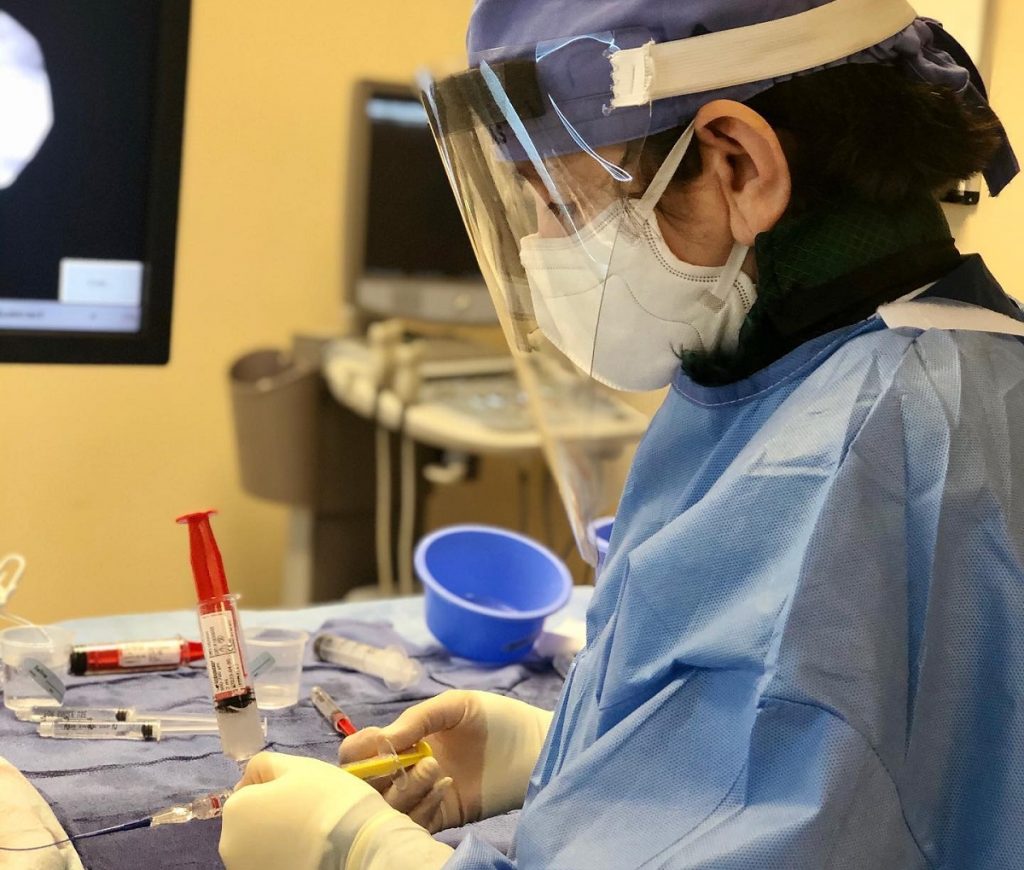If you experience ongoing problems or pain from uterine fibroids, the earlier you look into treatment options the faster you will find relief. Knowing this, you may set out to do a little research to see what is best for your situation. In searching for non-surgical fibroid removal, you might find yourself coming across two terms: uterine artery embolization (UAE) and uterine fibroid embolization (UFE). You may wonder: Am I a candidate for either procedure? What is the difference between the two?
This is a common question among fibroid patients. The quick answer is that uterine artery embolization and uterine fibroid embolization are terms often used to describe the same procedure. About 25,000 UAE procedures are performed around the world each year.
Why Is Uterine Artery Embolization Also Referred to as UFE?
Speaking more technically, uterine artery embolization applies generically to any procedure where uterine arteries are embolized. This can include embolization for adenomyosis, severe pelvic bleeding caused by trauma or malignant gynecological tumors, or emergency post-partum or post-operative bleeding.
UFE is a specialized form of uterine artery embolization. It is used solely for treating symptomatic fibroid tumors of the uterus. However, in many articles and medical journals, uterine artery embolization is mentioned interchangeably with UFE.
Why Hasn’t My Doctor Mentioned UFE Before?
A long time ago, many physicians, gynecologists, wellness doctors, and general practitioners may not have heard of uterine artery embolization. Or if they had, they needed more data about the procedure’s effectiveness. At that time, it was a hospital-only procedure. In addition, uterine artery embolization was performed mainly through the femoral artery (groin). The interventional radiologists who completed the procedure were not involved with the patient after the treatment was done. As a result, doctors who did refer patients initially were left handling patient post-op care for a procedure they did not perform. All this caused hesitancy for physicians to refer their patients for uterine artery embolization.
Fast forward to today and things have changed. Dr. Suzanne Slonim at Fibroid Institute Dallas has spent her career rewriting the story on fibroid treatment with embolization. Dr. Slonim focuses on patient comfort during and after fibroid treatment. She also performs UFE through the radial artery (wrist), not the femoral artery (groin). This allows patients to move around freely after the procedure instead of having to lay flat for 1-2 hours. In addition, the wrist approach reduces risk of bleeding.

What Happens During the Procedure?
As a specialized interventional radiologist, Dr. Slonim uses X-ray guidance to inject small particles into the blood vessels with a slender, flexible tube or catheter. This blocks blood flow to the fibroids and causes them to shrink. Surrounding healthy tissue is not affected because it continues to be fed by other unblocked vessels.
Dr. Slonim performs the procedure outpatient, so there is no hospital stay. The procedure takes approximately one hour. You will be asleep the entire time. When the procedure is complete, you can resume light activities as soon as you feel up to it. Most women return to work or regular daily activities in 7-10 days.

Other benefits of the procedure include:
- Performed under local anesthesia
- No incision
- Fibroid symptoms improve dramatically
- Avoids side effects of hormone therapies typically used to treat fibroids
After the procedure more than 90% of women notice an improvement in a variety of symptoms, including reduction of:
- Dull, chronic pelvic pain or pressure
- Abnormal menstrual bleeding and spotting
- Heavy periods lasting longer than a week
- Back or leg pain
- Constipation and/or bladder control issues
- Bloating or weight gain
- Anemia
- Pain during and/or after intercourse
What Are Possible Side Effects?
Unlike invasive surgeries such as hysterectomy and myomectomy, uterine artery embolization is a low-risk and viable alternative to fibroid surgery for many women.
The primary side effect after the procedure is pain. This can result as a reaction to stopping blood flow to the fibroids, as the abnormal tissue is dying. Pain usually peaks during the first 24 hours. However, Dr. Slonim effectively minimizes patient pain with a special algorithm.
With 25 years of experience and more than 30,000 procedures, Dr. Slonim has perfected a specific protocol in how she treats patients. Her methods ensure they have reduced discomfort and an overall better experience. Examples of this patient-first concierge care include:
As a result, more women every day, in consultation with their doctor, are choosing this as their preferred fibroid treatment option.
Here are just a few words real patients are saying about Dr. Suzanne Slonim and Fibroid Institute Dallas. In addition, you can watch video testimonials here.
“I was having so much pain for at least 2-3 days a month. I fully expected to just get some information and leave. After the explanation given to me by Dr. Slonim I was confident that I need to get this done. I had a full explanation before, during and after my procedure. I was able to get in touch with her for questions. Whenever I called, she answered promptly and pleasantly.”
– Tamika in Denton, TX
“Dr. Slonim is the best. She makes you feel so comfortable. I highly recommend her and her staff if you are weighing your options of fibroid treatments. She was my 3rd medical professional opinion that I felt secured in. My outcome experience was the best choice.”
– T. Jones in Grand Prairie, TX
“Dr. Slonim’s entire staff was caring and professional. The procedure was over before I knew anything. I had been suffering since 2008 and I finally was able to get a referral from my new OB-GYN. He said she was one of the best in the field and that she had lots of experience. My main concern was recovery and the amount of pain which is why I wanted an alternative to a hysterectomy. I am so grateful for the opportunity.”
– Lynn in McKinney, TX
“Dr. Slonim cares about her patients and listens to them. I had a great experience. On my consultation appointment, she walked me through all the details related to UFE. On the day of procedure, everything went well. For post-recovery Dr. Slonim and her team made it a painless process and managed and handled everything professionally. Indeed, she is the best doctor for UFE.”
– Jay in Dallas, TX
Schedule Your Consultation with Fibroid Institute Dallas
Like any medical condition, fibroids can get worse if left untreated. At Fibroid Institute Dallas, we are dedicated to treating fibroids and helping you live the life you deserve.
Dr. Suzanne Slonim is an interventional radiologist specializing in fibroid treatment without surgery. Dr. Slonim founded the Fibroid Institute Dallas and the Fibroid Free movement to relieve women of painful fibroid symptoms and educate them on treatment options other than a hysterectomy.
She is voted Best Doctor in D Magazine, honored with the Dallas Business Journal’s 2020 Women in Business Award, and listed in 2020 Super Doctors by Texas Monthly. Telehealth and/or in-office appointments are available for consultations. To learn more or to schedule, call 214-838-6440 or complete the form below.
Fibroid Institute Dallas serves the DFW area including Duncanville, DeSoto, Cedar Hill, Lancaster, Cockrell Hill, Highland Park, University Park, Park Cities, Grand Prairie, Arlington, HEB, Fort Worth, Hutchins, Irving, Garland, Mesquite, Richardson, Addison, Carrollton, Plano, Frisco, McKinney, Allen, Dallas, and all of North Texas.
Prior to starting any new treatment or questions regarding a medical condition, always seek the advice of your doctor or other qualified health provider. This information is not a substitute for professional medical advice.

